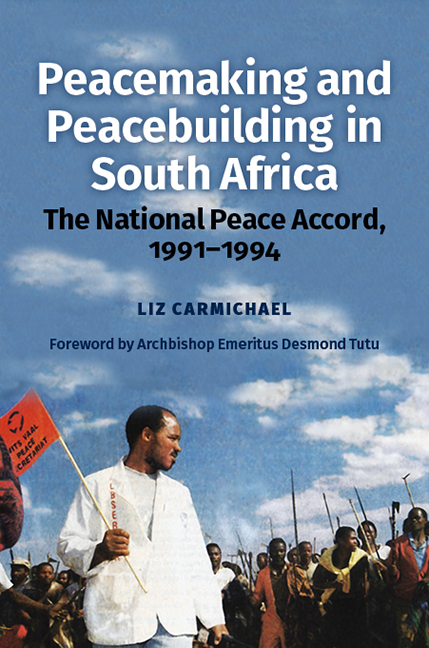Book contents
- Frontmatter
- Dedication
- Contents
- List of Illustrations
- List of Abbreviations
- Glossary
- Acknowledgements
- Note on Nomenclature
- Transition Timeline
- Foreword
- Introduction
- Part One Peacemaking, Peacebuilding, and the South African Conflict
- Part Two Peacemaking
- Part Three Peacebuilding
- Conclusion: Impact and Unfinished Business
- Bibliography
- Index
3 - Repression, Reform, Resistance, and Grassroots War
Published online by Cambridge University Press: 08 October 2022
- Frontmatter
- Dedication
- Contents
- List of Illustrations
- List of Abbreviations
- Glossary
- Acknowledgements
- Note on Nomenclature
- Transition Timeline
- Foreword
- Introduction
- Part One Peacemaking, Peacebuilding, and the South African Conflict
- Part Two Peacemaking
- Part Three Peacebuilding
- Conclusion: Impact and Unfinished Business
- Bibliography
- Index
Summary
Introduction
P. W. Botha, Prime Minister 1978–84 and State President 1984–89, attempted to reform apartheid while repressing all opposition. A new mass movement, the United Democratic Front (UDF), arose in reaction, demanding the ending of apartheid, while the exiled ANC called on the people to make the country ‘ungovernable’. Black trades unions, legalized after 1979, proved a powerful ANCaligned mobilizing force; but in Natal/KwaZulu conservative black reaction to strikes and the ‘ungovernability’ campaign morphed into civil war. Two overlapping violent conflicts now raged, which together were to prompt the Peace Accord: the people versus the government, and Inkatha versus ANC.
Government versus people: ‘total onslaught’ and ‘total strategy’
Botha had previously, since 1966, been Minister of Defence, responding to sanctions by energetically building up the SADF, complete with Military Intelligence, special forces, and a sophisticated arms industry that included secret nuclear weapons.
Botha and his generals adopted the terminology of the French counter-insurgency theorist General Andre Beaufre. Beaufre's thesis was that France could have won against the Algerian rebels in the 1950s had it introduced reforms and development, ‘winning hearts and minds’ by offering a better future under French, rather than rebel, rule. In Beaufre's language South Africa was being subjected, internally and externally, to a ‘total onslaught’ by international Communism, which must be met with a ‘total strategy’ that combined reform with repression. Beaufre's weakness was his failure to comprehend the popular yearning for freedom, but Botha was convinced and in 1977 he introduced the ‘total strategy’ doctrine to Parliament (Barnard, 2015 p.134).
Beaufre believed that for the sake of efficiency the military should run the ‘total strategy’ on the ground. Botha applied this doctrine, from 1979 to 1989, through his National Security Management System (NSMS). The NSMS was headed by the State Security Council (SSC), a Cabinet sub-committee chaired by the President, composed of intelligence and security personnel, attended by ministers and civil servants relevant to the topic under discussion. Contrary to popular suspicion the SSC was advisory to Cabinet and lacked executive powers.
- Type
- Chapter
- Information
- Peacemaking and Peacebuilding in South AfricaThe National Peace Accord, 1991-1994, pp. 33 - 46Publisher: Boydell & BrewerPrint publication year: 2022



